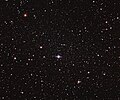Tập tin:Carina Dwarf Galaxy.jpg

Kích thước hình xem trước: 719×600 điểm ảnh. Độ phân giải khác: 288×240 điểm ảnh | 576×480 điểm ảnh | 921×768 điểm ảnh | 1.228×1.024 điểm ảnh | 2.456×2.048 điểm ảnh | 3.771×3.145 điểm ảnh.
Tập tin gốc (3.771×3.145 điểm ảnh, kích thước tập tin: 5,64 MB, kiểu MIME: image/jpeg)
Lịch sử tập tin
Nhấn vào ngày/giờ để xem nội dung tập tin tại thời điểm đó.
| Ngày/giờ | Hình xem trước | Kích cỡ | Thành viên | Miêu tả | |
|---|---|---|---|---|---|
| hiện tại | 13:14, ngày 24 tháng 2 năm 2015 |  | 3.771×3.145 (5,64 MB) | FDMS4 | Reverted to version as of 14:03, 28 June 2011. |
| 03:00, ngày 24 tháng 2 năm 2015 |  | 3.768×3.144 (5,78 MB) | SteinsplitterBot | Bot: Image rotated by 180° | |
| 14:03, ngày 28 tháng 6 năm 2011 |  | 3.771×3.145 (5,64 MB) | Jmencisom |
Trang sử dụng tập tin
Có 1 trang tại Wikipedia tiếng Việt có liên kết đến tập tin (không hiển thị trang ở các dự án khác):
Sử dụng tập tin toàn cục
Những wiki sau đang sử dụng tập tin này:
- Trang sử dụng tại af.wikipedia.org
- Trang sử dụng tại ar.wikipedia.org
- Trang sử dụng tại ast.wikipedia.org
- Trang sử dụng tại ca.wikipedia.org
- Trang sử dụng tại de.wikipedia.org
- Trang sử dụng tại el.wikipedia.org
- Trang sử dụng tại en.wikipedia.org
- Trang sử dụng tại es.wikipedia.org
- Trang sử dụng tại fi.wikipedia.org
- Trang sử dụng tại fr.wikipedia.org
- Trang sử dụng tại he.wikipedia.org
- Trang sử dụng tại id.wikipedia.org
- Trang sử dụng tại it.wikipedia.org
- Trang sử dụng tại ja.wikipedia.org
- Trang sử dụng tại ko.wikipedia.org
- Trang sử dụng tại mk.wikipedia.org
- Trang sử dụng tại nl.wikipedia.org
- Trang sử dụng tại no.wikipedia.org
- Trang sử dụng tại pl.wikipedia.org
- Trang sử dụng tại pt.wikipedia.org
- Trang sử dụng tại ro.wikipedia.org
- Trang sử dụng tại ru.wikipedia.org
- Trang sử dụng tại si.wikipedia.org
- Trang sử dụng tại sk.wikipedia.org
- Trang sử dụng tại tr.wikipedia.org
- Trang sử dụng tại uk.wikipedia.org
- Trang sử dụng tại www.wikidata.org
